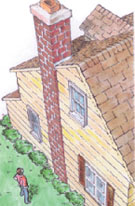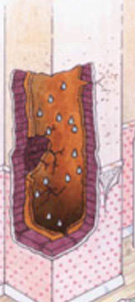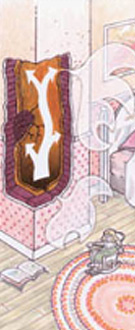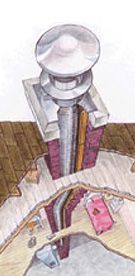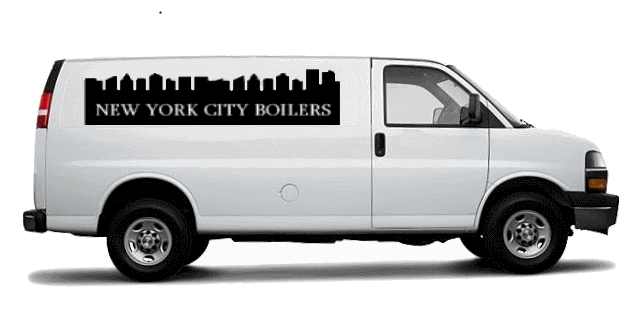|
|
"But my furnace chimney looks fine on the outside." |
|
Many chimneys venting gas or oil furnaces or hot water heaters may appear to be in fine condition on the outside. But inside it could be a completely different situation. Yesterday's chimneys were not designed for venting today's more energy efficient appliances. Let's take a close look at what really counts... the inside. |
|
|
Chimney Services |
We can reline virtually any chimney configuration you may have from single, straight flues, to multiple flues and flues with bends and size changes. Call us for all the details!
|
|
Cement Crown Installation |
|
|
Now look inside, see the problems? |
|
A look at the inside of this same chimney shows how acid-laden residue from the furnace has attacked this flue. The original clay liner has eroded away; pieces of it are even missing. (Old chimneys might not even have a liner.) Mortar and bricks are loose and falling, and moisture has leeched through to the home's interior walls. With continued use, more erosion will take place, possibly leading to leaks in the flue, complete flue blockage, or possibly even carbon monoxide poisoning of the home's occupants. |
|
|
|
Chimney problems can cause illness and even loss of lives. |
|
|
It's happened thousands of times - illness, even death, from carbon monoxide or sulfur dioxide poisoning. With deterioration of the flue, the deadly gases can find their way into your home through even the smallest cracks. In severe cases, the chimney erosion will lead to partial or complete internal collapse, blocking the flue and sending these poisonous gases into the home. But fortunately, the problems of a deteriorating gas or oil furnace flue can be corrected without completely rebuilding your chimney. |
||
|
|
Revitalize your chimney with a Chimney Relining System |
|
|
These LINERS were developed specifically to resist corrosive flue acids. A liner acts as a barrier between the flue gases and the defects in your chimney walls. Not only will it add to the safety of your home and family, it will also increase the resale value of your home. And, your furnace will run more efficiently. This dependable, high-quality product comes with the best lifetime warranty in the industry. |
||
|
Why use a chimney liner? |
|
The most important reasons for using a chimney liner would be to correct problems with an existing masonry chimney that has become unsafe due to deterioration, moisture damage or eroded mortar joints. Another reason is to improve the efficiency of the appliance by reducing the existing chimney to the correct flue size to match the appliance it serves. By doing so, you will be improving the draft, reducing fuel consumption and ensuring consistent operation. |
|
My masonry chimney is in bad shape; can I still install a chimney liner in it? |
|
Prior to installing a liner in your masonry chimney, make sure the masonry chimney is in sound condition, clean and free from all loose and potentially flammable debris. If you find any cracked, loose or missing bricks or tiles, have them replaced. If in doubt, contact a professional chimney sweep and/or a qualified heating system technician for a thorough inspection. |
|
Should I just get a new appliance instead of repairing my old one? |
|
New Appliances installed today yield higher efficiencies than yesterday's technology. This helps you save by increasing the amount of usable heat for your home generated by each BTU of fuel you burn. Higher efficiencies effectively help you "send less money up-the chimney". However, because more heat is used by the home, there is less heat in the exhaust gases vented to the outside. If not vented properly, these lower temperature exhaust gases can lead to excessive moisture in your chimney (or not vent at all!). |
|
Why is moisture bad for the inside of a Chimney? |
|
Moisture, over time, will cause corrosion and decay or bricks, mortar and clay liners. How? Moisture reacts with the exhaust gases to form acids which "eat away" at your chimney. Also, moisture collects into cracks and can seep into bricks and mortar. In cold climates, the moisture freezes, expands, then thaws, causing chunks of your chimney to break loose and crumble. Finally, moisture can actually drip back into your Appliance, causing it to rust or corrode. |
|
How does a chimney Liner protect my Chimney? |
|
Flexible Chimney Liners have two primary ways of protecting your chimney: |
|
When is a Stainless Steel Chimney Liner used vs an Aluminum Chimney Liner? |
|
Stainless Steel Chimney Liners are listed for use with Oil and Wood burning appliances. Aluminum is used in Gas installations, where flue temperatures are much lower and corrosive gases are much less. |
|
|

